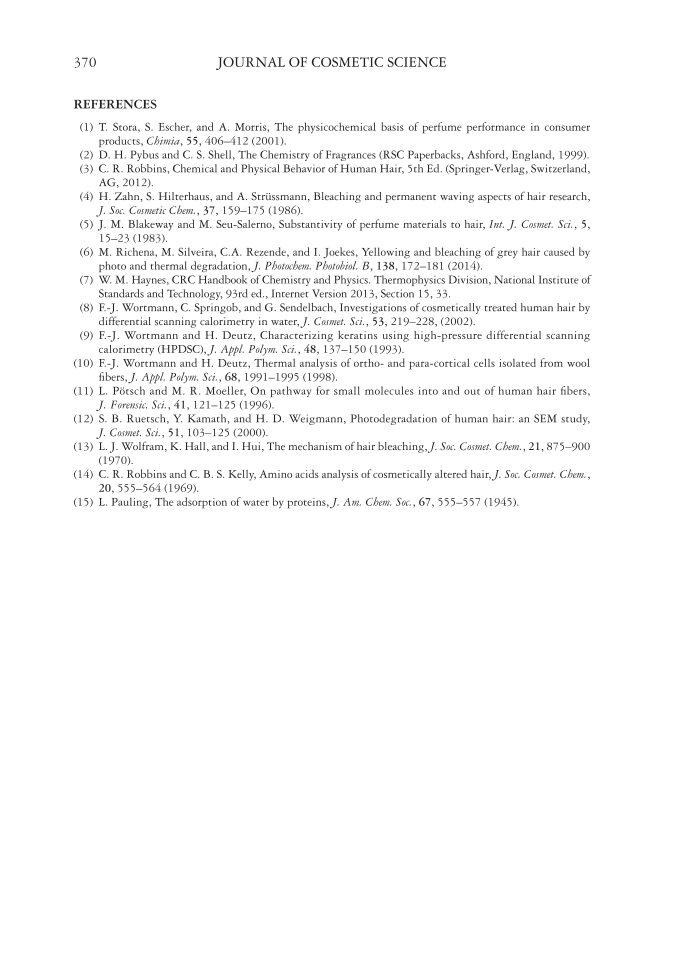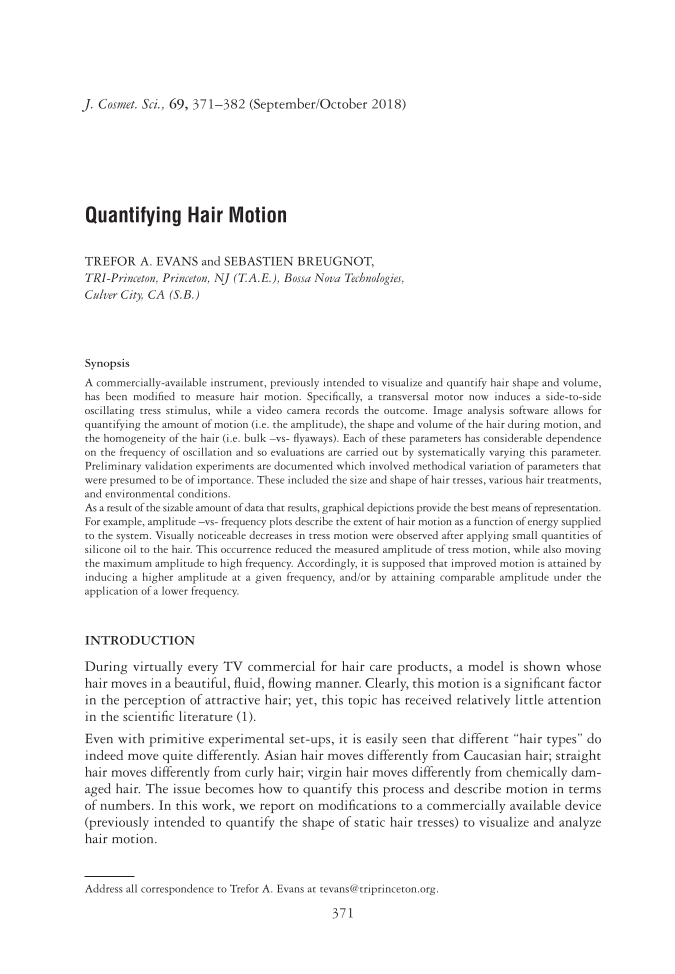JOURNAL OF COSMETIC SCIENCE 370 REFERENCES (1) T. Stora, S. Escher, and A. Morris, The physicochemical basis of perfume performance in consumer products, Chimia, 55, 406–412 (2001). (2) D. H. Pybus and C. S. Shell, The Ch emistry of Fragrances (RSC Paperbacks, Ashford, England, 1999). (3) C. R. Robbins, Chemical and Physica l Behavior of Human Hair, 5th Ed. (Springer-Verlag, Switzerland, AG, 2012). (4) H. Zahn, S. Hilterhaus, and A. Strü ssmann, Bleaching and permanent waving aspects of hair research, J. Soc. Cosmetic Chem., 37, 159–175 (1986). (5) J. M. Blakeway and M. Seu-Salerno, S ubstantivity of perfume materials to hair, Int. J. Cosmet. Sci., 5, 15–23 (1983). (6) M. Richena, M. Silveira, C.A. Rezend e, and I. Joekes, Yellowing and bleaching of grey hair caused by photo and thermal degradation, J. Photochem. Photobiol. B, 138, 172–181 (2014). (7) W. M. Haynes, CRC Handbook of Chemistry and Physics. Thermophysics Division, National Institute of Standards and Technology, 93rd ed., Internet Version 2013, Section 15, 33. (8) F.-J. Wortmann, C. Springob, and G. Sendelbach, Investigations of cosmetically treated human hair by differential scanning calorimetry in water, J. Cosmet. Sci., 53, 219–228, (2002). (9) F.-J. Wortmann and H. Deutz, Charact erizing keratins using high-pressure differential scanning calorimetry (HPDSC), J. Appl. Polym. Sci., 48, 137–150 (1993). (10) F.-J. Wortmann and H. Deutz, Therma l analysis of ortho- and para-cortical cells isolated from wool fi bers, J. Appl. Polym. Sci., 68, 1991–1995 (1998). (11) L. Pötsch and M. R. Moeller, On pat hway for small molecules into and out of human hair fi bers, J. Forensic. Sci., 41, 121–125 (1996). (12) S. B. Ruetsch, Y. Kamath, and H. D. Weigmann, Photodegradation of human hair: an SEM study, J. Cosmet. Sci., 51, 103–125 (2000). (13) L. J. Wolfram, K. Hall, and I. Hui, The mechanism of hair bleaching, J. Soc. Cosmet. Chem., 21, 875–900 (1970). (14) C. R. Robbins and C. B. S. Kelly, Am ino acids analysis of cosmetically altered hair, J. Soc. Cosmet. Chem., 20, 555–564 (1969). (15) L. Pauling, The adsorption of water b y proteins, J. Am. Chem. Soc., 67, 555–557 (1945).
J. Cosmet. Sci., 69, 371–382 (September/October 2018) 371 Quantifying Hair Motion TREFOR A. EVANS and SEBASTIEN BREUGNOT, TRI-Princeton, Princeton, NJ (T.A.E.), Bossa Nova Technologies, Culver City, CA (S.B.) Synopsis A commercially-available instrument, previously intended to visualize and quantify hair shape and volume, has been modifi ed to measure hair motion. Specifi cally, a transversal motor now induces a side-to-side oscillating tress stimulus, while a video camera records the outcome. Image analysis software allows for quantifying the amount of motion (i.e. the amplitude), the shape and volume of the hair during motion, and the homogeneity of the hair (i.e. bulk –vs- fl yaways). Each of these parameters has considerable dependence on the frequency of oscillation and so evaluations are carried out by systematically varying this parameter. Preliminary validation experiments are documented which involved methodical variation of parameters that were presumed to be of importance. These included the size and shape of hair tresses, various hair treatments, and environmental conditions. As a result of the sizable amount of data that results, graphical depictions provide the best means of representation. For example, amplitude –vs- frequency plots describe the extent of hair motion as a function of energy supplied to the system. Visually noticeable decreases in tress motion were observed after applying small quantities of silicone oil to the hair. This occurrence reduced the measured amplitude of tress motion, while also moving the maximum amplitude to high frequency. Accordingly, it is supposed that improved motion is attained by inducing a higher amplitude at a given frequency, and/or by attaining comparable amplitude under the application of a lower frequency. INTRODUCTION During virtually every TV commercial for hair care products, a model is shown whose hair moves in a beautiful, fl uid, fl owing manner. Clearly, this motion is a signifi cant factor in the perception of attractive hair yet, this topic has received relatively little attention in the scientifi c literature (1). Even with primitive experimental set-ups, it is easily seen that different “hair types” do indeed move quite differently. Asian hair moves differently from Caucasian hair straight hair moves differently from curly hair virgin hair moves differently from chemically dam- aged hair. The issue becomes how to quantify this process and describe motion in terms of numbers. In this work, we report on modifi cations to a commercially available device (previously intended to quantify the shape of static hair tresses) to visualize and analyze hair motion. Address all correspondence to Trefor A. Evans at tevans@triprinceton.org.
Purchased for the exclusive use of nofirst nolast (unknown) From: SCC Media Library & Resource Center (library.scconline.org)









































































































